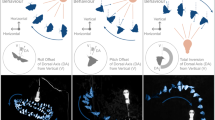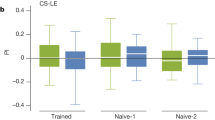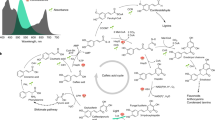Abstract
Plants respond to insect herbivory by synthesizing and releasing complex blends of volatile compounds, which provide important host-location cues for insects that are natural enemies of herbivores1,2,3. The effects of these volatile blends on herbivore behaviour have been investigated to only a limited extent4,5, in part because of the assumption that herbivore-induced volatile emissions occur mainly during the light phase of the photoperiod6,7. Because many moths—whose larvae are some of the most important insect herbivores—are nocturnal, herbivore-induced plant volatiles have not hitherto been considered to be temporally available as host-location cues for ovipositing females. Here we present chemical and behavioural assays showing that tobacco plants (Nicotiana tabacum) release herbivore-induced volatiles during both night and day. Moreover, several volatile compounds are released exclusively at night and are highly repellent to female moths (Heliothis virescens). The demonstration that tobacco plants release temporally different volatile blends and that lepidopteran herbivores use induced plant signals released during the dark phase to choose sites for oviposition adds a new dimension to our understanding of the role of chemical cues in mediating tritrophic interactions.
This is a preview of subscription content, access via your institution
Access options
Subscribe to this journal
Receive 51 print issues and online access
$199.00 per year
only $3.90 per issue
Buy this article
- Purchase on Springer Link
- Instant access to full article PDF
Prices may be subject to local taxes which are calculated during checkout


Similar content being viewed by others
References
Dicke, M. Local and systemic production of volatile herbivore-induced terpenoids: their role in plant-carnivore mutualism. J. Plant Physiol. 143, 465–472 (1994).
Turlings, T. C. J., Tumlinson, J. H. & Lewis, W. J. Exploitation of herbivore-induced plant odors by host-seeking parasitic wasps. Science 250, 1251–1253 (1990).
McCall, P. J., Turlings, T. C. J., Lewis, W. J. & Tumlinson, J. H. Role of plant volatiles in host location by the specialist parasitoid Microplitis croceipes Cresson (Braconidae:Hymenoptera). J. Insect Behav. 6, 625–639 (1993).
Pallini, A., Jansen, A. & Sabelis, M. Odour-mediated responses of phytophagous mites to conspecific and heterospecific competitors. Oecologia 110, 179–185 (1997).
Karban, R. & Baldwin, I. T. Induced Responses to Herbivory (Univ. Chicago Press, Chicago, Illinois, 1997).
Paré, P. W. & Tumlinson, J. H. Induced synthesis of plant volatiles. Nature 385, 30–31 (1997).
Loughrin, J. H., Manukian, A., Heath, R. R. & Tumlinson, J. H. Diurnal cycle of emission of induced volatile terpenoids by herbivore-injured cotton plants. J. Chem. Ecol. 21, 1217–1227 (1994).
Turlings, T. C. J. et al. How caterpillar-damaged plants protect themselves by attracting parasitic wasps. Proc. Natl Acad. Sci. USA 92, 4169–4174 (1995).
Karban, R. Resistance against spider mites in cotton induced by mechanical abrasion. Entomol. Exp. Appl. 37, 137–141 (1985).
Dicke, M. et al. Isolation and identification of volatile kairomone that affects acarine predator-prey interactions. Involvement of host plant in its production. J. Chem. Ecol. 16, 381–396 (1990).
Mattiacci, L., Dicke, M. & Posthumus, M. A. Induction of parasitoid attracting synomone in brussels sprouts plants by feeding of Pieris brassicae larvae: Role of mechanical damage and herbivore elicitor. J. Chem. Ecol. 20, 2229–2247 (1994).
Alborn, H. T. et al. An elicitor of plant volatiles from beet armyworm oral secretion. Science 276, 945–948 (1997).
De Moraes, C. M. et al. Herbivore-infested plants selectively attract parasitoids. Nature 393, 570–573 (1998).
Dicke, M. Volatile spider-mite pheromone and host plant kairomone, involved in spaced-out gregariousness in spider mite Tetranychus urticae. Physiol. Entomol. 11, 251–262 (1986).
Schultz, S. et al. Host plant selection of the Colorado Potato Beetle as influenced by damage induced volatiles of the potato plant. Naturwissenschaften 84, 212–217 (1997).
Harari, A. R., Ben-Yakir, D. & Rosen, D. Mechanisms of aggregation behavior in Maladera matrida Argaman (Coleoptera: Scarabeidae). J. Chem. Ecol. 20, 361–371 (1994).
Landolt, P. J., Tumlinson, J. H. & Alborn, D. H. Attraction of Colorado potato beetle (Coleoptera : Chrysomelidae) to damaged and chemically induced potato plants. Environ. Entomol. 28, 973–978 (1999).
Landolt, P. J. Effects of host plant leaf damage on cabbage looper moth attraction and oviposition. Entomol. Exp. Appl. 67, 79–85 (1993).
Heath, R. R. & Tumlinson, J. H. Prediction of release ratios of multicomponent pheromones from rubber septa. J. Chem. Ecol. 12, 2081–2088 (1986).
Heath, R. R., Teal, P. E. A., Tumlinson, J. H. & Mengelkoch, L. J. Correlation of retention times on liquid crystal capillary column with reported vapor pressures and half-lives of compounds used in pheromone formulations. J. Chem. Ecol. 12, 2133–2143 (1986).
Thaler, J. S. Jasmonate-inducible plant defenses cause increased parasitism of herbivores. Nature 399, 686–588 (1999).
Agrawal, A. A. Induced responses to herbivory and increased plant performance. Science 279, 1201–1202 (1998).
Coley, P. D., Bryant, J. P. & Chapin, F. S. Resource availability and plant antiherbivore defense. Science 230, 895–899 (1985).
Heath, R. R. & Manukian, A. An automated-system for use in collecting volatile chemicals released from plants. J. Chem. Ecol. 20, 593–608 (1994).
Acknowledgements
We thank G. W. G. De Moraes for discussions; H. T. Alborn, J. G. Hildebrand, P. J. Landolt, W. J. Lewis, K. G. Ross and J. R. Ruberson for comments on the manuscript; and B. Dueben and M. Sammons for technical assistance.
Author information
Authors and Affiliations
Corresponding author
Rights and permissions
About this article
Cite this article
De Moraes, C., Mescher, M. & Tumlinson, J. Caterpillar-induced nocturnal plant volatiles repel conspecific females. Nature 410, 577–580 (2001). https://doi.org/10.1038/35069058
Received:
Accepted:
Issue Date:
DOI: https://doi.org/10.1038/35069058
This article is cited by
-
Simulated Herbivory Affects the Volatile Emissions of Oak Saplings, while Neighbourhood Affects Flavan-3-ols Content of Their Leaves
Journal of Chemical Ecology (2024)
-
Green leaf volatile sensory calcium transduction in Arabidopsis
Nature Communications (2023)
-
Genome-wide identification, expression profile and evolutionary relationships of TPS genes in the neotropical fruit tree species Psidium cattleyanum
Scientific Reports (2023)
-
Fitness consequences of oviposition choice by an herbivorous insect on a host plant colonized by an endophytic entomopathogenic fungus
Journal of Pest Science (2023)
-
Beyond 'push–pull': unraveling the ecological pleiotropy of plant volatile organic compounds for sustainable crop pest management
Crop Health (2023)
Comments
By submitting a comment you agree to abide by our Terms and Community Guidelines. If you find something abusive or that does not comply with our terms or guidelines please flag it as inappropriate.



